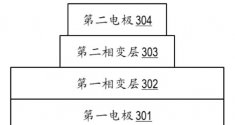Interpretation of a solution for Huawei phase change memory
Note: Phase change memory, referred to as PCM (Phase Change Memory)
Structure and composition
PCM includes multiple phase change memory cells, each unit including an upper electrode, a lower electrode and two phase change layers between the two electrodes (as shown in the figure, the upper and lower structures, from the upper electrode to the lower electrode will pass through the two phase change layer, that is, the second phase change layer and the first phase change layer in the figure).
physical properties
·The cross-sectional area of the upper electrode < the cross-sectional area of the lower electrode
·The cross-sectional area of the phase change layer close to the upper electrode ≤ the cross-sectional area of the phase change layer close to the lower electrode
·The melting temperature of the phase change layer close to the upper electrode < the melting temperature of the phase change layer close to the lower electrode
Solution advantages
This solution can accelerate the crystallization process, effectively increase the phase change speed, and accelerate the storage writing speed.

Note: Phase change memory, referred to as PCM (Phase Change Memory)
Structure and composition
PCM includes multiple phase change memory cells, each unit including an upper electrode, a lower electrode and two phase change layers between the two electrodes (as shown in the figure, the upper and lower structures, from the upper electrode to the lower electrode will pass through the two phase change layer, that is, the second phase change layer and the first phase change layer in the figure).
physical properties
·The cross-sectional area of the upper electrode < the cross-sectional area of the lower electrode
·The cross-sectional area of the phase change layer close to the upper electrode ≤ the cross-sectional area of the phase change layer close to the lower electrode
·The melting temperature of the phase change layer close to the upper electrode < the melting temperature of the phase change layer close to the lower electrode
Solution advantages
This solution can accelerate the crystallization process, effectively increase the phase change speed, and accelerate the storage writing speed.

